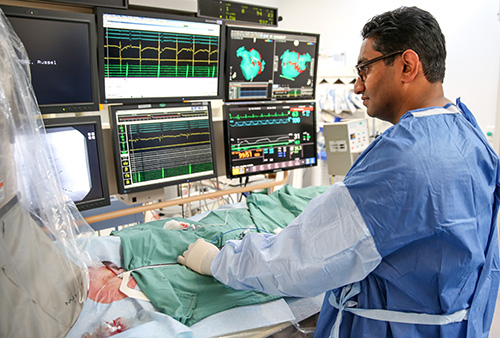New insights into a common heart condition

Professor Prash Sanders
Pioneering research by University of Adelaide Professor Prash Sanders is providing vital insights into atrial fibrillation, a potentially fatal and previously little understood condition.
Prash Sanders came to a surprise conclusion as a medical registrar when he observed cardiac specialists treating people suffering from irregular heartbeats. They were all using a different approach. "It was pretty obvious at the time that no-one knew exactly how to manage the condition," says Professor Sanders. And they weren't alone. Atrial fibrillation was a common illness which had cardiac experts worldwide struggling to fully understand and to standardise management. The young Prash Sanders made it his goal to find out more.
After graduating with honours from the University of Adelaide in 1994, he undertook physician and cardiology training at the Royal Adelaide Hospital before doing clinical training and a PhD in cardiac electrophysiology in Melbourne. These were all steps in a carefully planned journey that would take him to Bordeaux in France where Professor Michel Ha´ssaguerre was pioneering a new treatment called catheter ablation. Professor Sanders won a prestigious Neil Hamilton Fairly Fellowship to work with Professor Ha´ssaguerre and for the next four years learned all he could about complex ablation techniques involving cauterising areas of heart muscle to interrupt abnormal electrical impulses and, in many cases, cure rhythm disturbances. He brought his new-found expertise back to Adelaide in 2005 when he established a dedicated electrophysiology laboratory to pursue further groundbreaking research. He's come a long way since. Today he is Director of the University's Centre for Heart Rhythm Disorders and heads an 80-strong team based at the South Australian Health and Medical Research Institute, University of Adelaide and the Royal Adelaide Hospital. Their work is helping to save numerous lives. An estimated 2% of people suffer from atrial fibrillation which has been identified as a leading cause of strokes and hospitalisation. "I've been fortunate to have been involved in exploring and designing some of the techniques to cure people of atrial fibrillation and we're now introducing these techniques in Australia," says Professor Sanders. "Important to the success of my group, which extends from basic science concepts through to the clinic, is the support and integration of services between the University and hospital environments. "We have been fortunate to have attracted high-quality students back to the University, which has been fantastic." Among the key initiatives is a major collaborative trial involving cardiac electrophysiologists across Australia and New Zealand to evaluate treatment options. The study, which is being led by Professor Sanders, is looking at new ways of using a cardiac resynchronisation device to improve heart pumping. "This is the first trial of its type and by joining forces in this way we have a much greater chance of having a high clinical impact," he says. But while better treatment options are important, Professor Sanders is particularly focused on addressing the various risk factors that cause the condition - factors which until recent years were not considered connected. They include hypertension, diabetes, smoking, alcohol abuse, high cholesterol, obesity and sleep apnoea.
|





